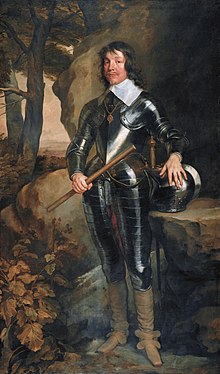
Back Bitva u Prestonu Czech Schlacht von Preston (1648) German Bataille de Preston French Battaglia di Preston (1648) Italian プレストンの戦い (1648年) Japanese Bitwa pod Preston (1648) Polish Битва при Престоне (1648) Russian Битка код Престона Serbian Slaget vid Preston Swedish ยุทธการที่เพรสตัน Thai
| Battle of Preston | |||||||
|---|---|---|---|---|---|---|---|
| Part of the Second English Civil War | |||||||
 James Hamilton, commander of the invading Scottish army | |||||||
| |||||||
| Belligerents | |||||||
|
|
| ||||||
| Commanders and leaders | |||||||
|
|
| ||||||
| Strength | |||||||
| c.24,000, not all of whom were engaged | 11,100, of whom 9,000 were engaged | ||||||
| Casualties and losses | |||||||
|
| ||||||
Location of the battle in Lancashire, showing modern administrative boundaries | |||||||
The battle of Preston was fought on 17 August 1648 during the Second English Civil War near the Lancashire town of Preston between part of a Royalist army under James Hamilton, Duke of Hamilton, and a considerably smaller Parliamentarian army commanded by Lieutenant General Oliver Cromwell. The Royalists were defeated with heavy losses.
The First English Civil War between Royalist supporters of Charles I and an alliance of Parliamentarian and Scottish forces ended in 1646 with Charles defeated and imprisoned. He continued to negotiate with several factions among his opponents and this sparked the Second English Civil War in 1648. It began with a series of mutinies and Royalist uprisings in England and Wales. Meanwhile, a political struggle in Scotland led to a faction which supported Charles, known as the Engagers, gaining power. They raised an army which crossed into England at Carlisle on 8 July to support these risings. Combining with English Royalists they marched south along the west coast road some 24,000 strong. Cromwell was suppressing risings in south Wales with 5,000 men during May and June; he captured the last Royalist stronghold on 11 July and was marching east within a week.
Cromwell concentrated 9,000 men in north Yorkshire and crossed the Pennines to fall on the flank of the much larger Royalist army at Preston. Not contemplating that Cromwell would act so recklessly Hamilton was caught with his army on the march and with large detachments too far away to intervene. A blocking force of about 3,000 English Royalist infantry, many ill-armed and inadequately trained, proved no match for the Parliamentarians, most of whom were well-trained veterans from the New Model Army. After a ferocious hour-long fight these Royalists were outflanked on both sides, which caused them to break. The largest part of the Royalist army, predominately Scottish, was marching south immediately to the rear of this fighting. Most had crossed a bridge over the Ribble, a major river just south of Preston, those still to the north of it were swept away by the Parliamentarian cavalry and either killed or taken prisoner. A second round of prolonged infantry hand-to-hand fighting took place for control of the bridge; the Parliamentarians were again victorious, fighting their way across as night fell.
Most of the survivors, nearly all Scottish, were to the south of Preston. Although still at least as strong as the whole Parliamentarian army they fled towards Wigan in a night march. They were hotly pursued and on the 19th were caught and defeated again at the battle of Winwick. All of the surviving Scots surrendered: their infantry either at Winwick or nearby Warrington, their cavalry on 24 August at Uttoxeter. In the aftermath of the war Charles was beheaded on 30 January 1649 and England became a republic on 19 May.
